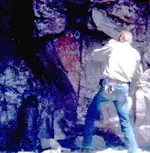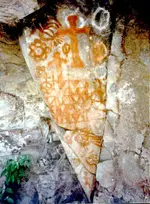What an awesome find!!!! I'm going to have to respectfully disagree with Bustit's opinions on a few points. I'm Southern Cherokee and Comanche, so I know first hand how symbolism changes drastically from tribe to tribe. Just as an example, to the Cherokee, the Owl is a holy symbol, filled with luck. To the Navajo, however, the Owl is a dreaded omen of pending death. I think it's important to not just lump all natives into the "Indian" category. Each nation, tribe, band, clan and family has their own little take on things.
The crosses, in my opinion, look like crosses. The large, predominant one looks to me like nothing other than a cross, with the flared ends and all. The smaller one at mid-left reminds me of the ornate globes, topped with a cross, that you see on Catholic hats/staffs/etc.
Some tribes did put crosses in their petroglyphs, if they had been exposed to Christianity. In many cases, tribes which had been subjugated by Catholic missions, the Indians would adopt Christian symbols while secretly assigning to them traditional Indian meanings. In this way, they could continue to worship how they wanted, but to Spanish/Italian eyes, it looked like they had converted to Christianity.
I would point out that in Utah, they are starting to realize that some (not all) of the snake petroglyphs and pictographs superimpose nicely over nearby rivers, suggesting they are not just snakes, but maps as well.
The geometric design toward the bottom is, again in my opinion, some type of code, otherwise it would be uniform in nature and not so "random" in appearance. I always try to remember how hard and time consuming it must have been to chip away for hours or days at a time to create an elaborate petroglyph. Obviously, they must have significant meaning. What I'm trying to say is I doubt any petroglyph was meant simply as decoration. When I see this geometric design, it smacks of decoration (albeit intentionally "imperfect"), which makes me think 1) non-aboriginal, and 2) coded.
What is also very interesting to me is the stone face the "authors" put the message on. It's a near-perfect triangle. May mean nothing at all. I don't know. Could be a "pointer" or could have simply been chosen for its aesthetic value.
Lastly, I noticed that the bird designs are VERY similar to ones I've seen in Garden Canyon in the Huachuca Mountains of So. AZ. Archaeologists say those are Anasazi or Apache. They're probably right, but there was a LOT of Jesuit activity in the area. The mountains have several Spanish mines, and lay right between two of Father Eusebio Kino's missions.
Again, I don't mean any disrespect to Bustit's view. This is just my opinion. Good luck!!!!!





 Thanks for the info though I will keep it in mind if i do come across somethign like this.
Thanks for the info though I will keep it in mind if i do come across somethign like this. ) I got offended in the Army when I got Article 15'd for not going to Christmas Mass. But nothing you said even comes close to being offensive. I for one am always learning about other cultures, so it's sure as hell not offensive when someone learns about mine. Refreshing, actually.
) I got offended in the Army when I got Article 15'd for not going to Christmas Mass. But nothing you said even comes close to being offensive. I for one am always learning about other cultures, so it's sure as hell not offensive when someone learns about mine. Refreshing, actually.